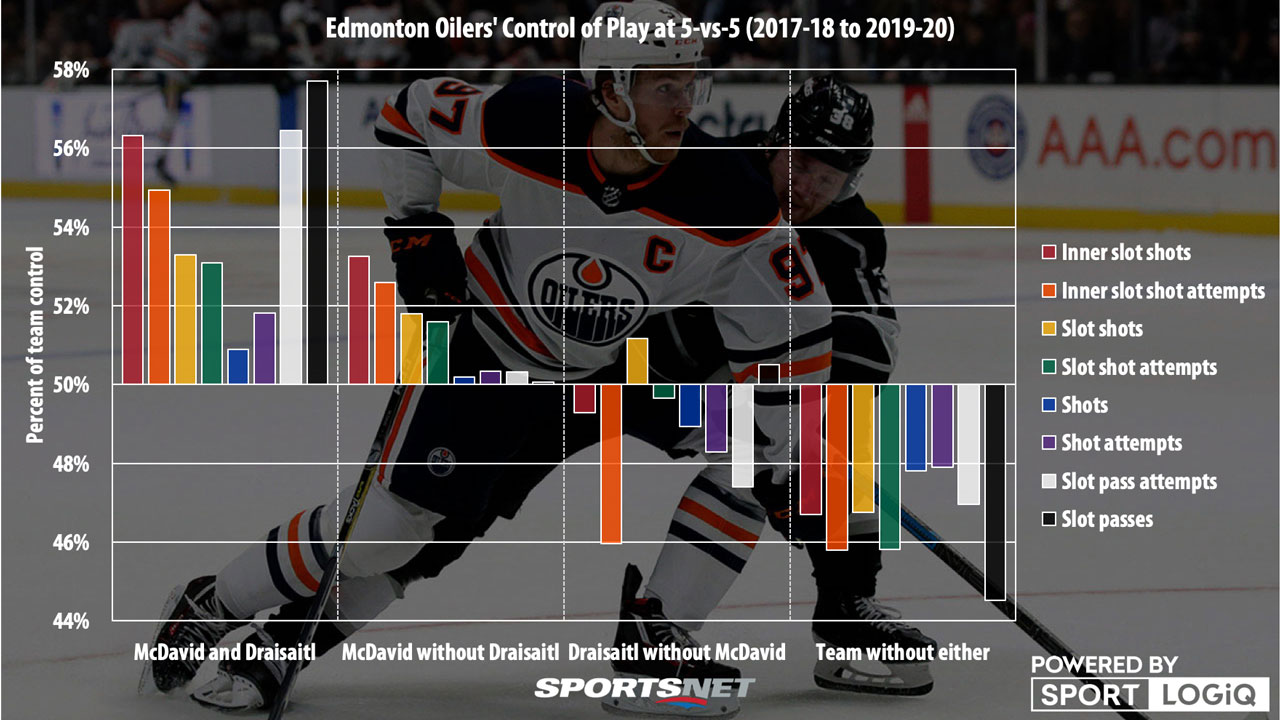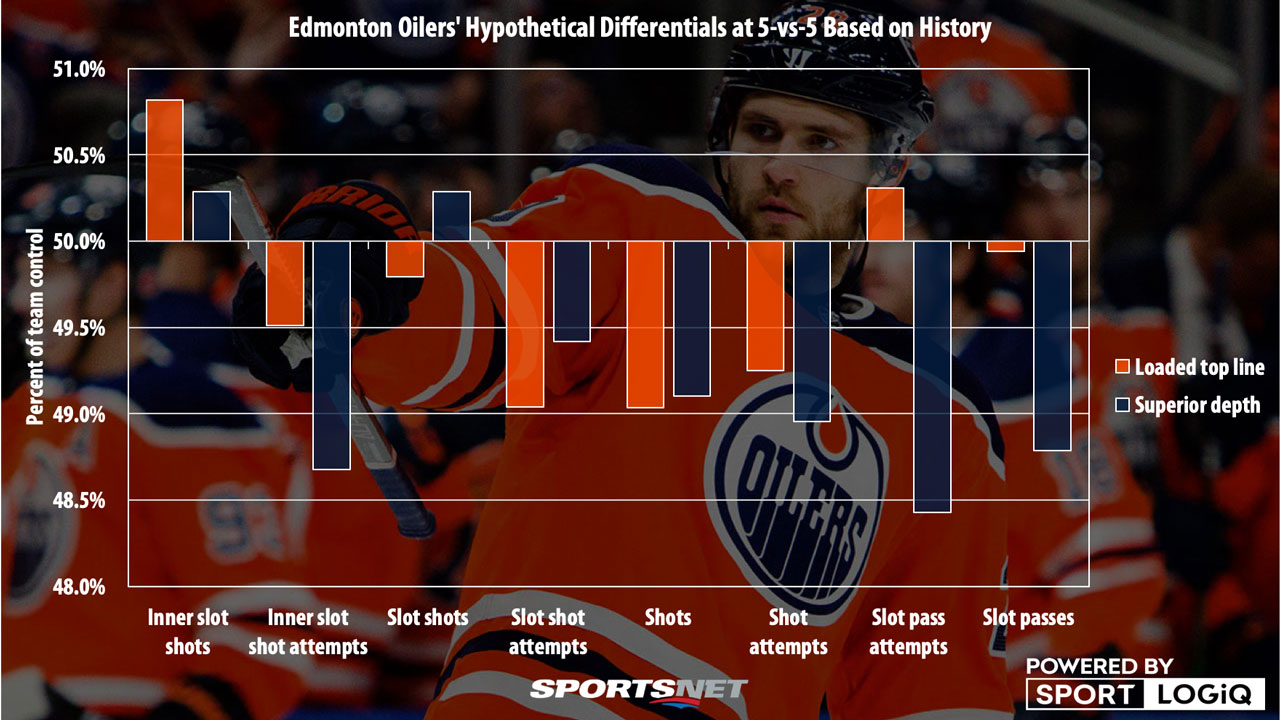It’s no secret that the Edmonton Oilers are in free fall right now. Still clinging onto playoff position in the Pacific division despite a negative goal differential and a 3-6-1 record in their last 10 games, the Oilers are scrambling for answers while being outplayed at even strength and seeing their early strengths in goal eroding so drastically that they’ve become their biggest weakness.
Giving Mikko Koskinen the net and letting Mike Smith sit has really helped stabilize that situation the last few games, but whenever the Oilers struggle the same question rears its head over and over again; is it finally time to split up Connor McDavid and Leon Draisaitl to give the team more depth to play with?
There has been some skepticism in the past over whether Draisaitl is a top player away from McDavid, but every time I’ve looked into his individual contributions he stacks up as one of the better players in the league both offensively and in transition, along with not being terrible defensively, so I don’t think that’s necessarily the case.
The Oilers’ lack of winger depth does make it difficult to craft multiple complete lines though, even with dominant centres you need some level of talent to play off of, so let’s look at the last three years of Oilers hockey and see what actually happens when you split up the dynamic duo, and what the Oilers actually look like with both of them off the ice.
Using three seasons worth of data, and a fairly significant cross section of metrics, it’s a lot to take in, but let’s try to break it down.

McDavid and Draisaitl together are incredible, which I know isn’t telling anyone anything new, but the gap between what happens when they’re on the ice and when they’re off it is so extreme. On average across these metrics, the Oilers moved from controlling 46.5 per cent of play at 5-vs-5 to 54.3 per cent when Draisaitl and McDavid came off the bench over the last couple seasons. That’s nearly and 8 percentage point change in differentials, which is huge on its own but also doesn’t tell the whole story.
The areas where McDavid and Draisaitl make the biggest impacts are in high quality plays, and those are the areas where the Oilers fall off most harshly without them on the ice.
In inner slot shot differential, the Oilers are nearly 10 percentage points better with McDavid and Draisaitl on the ice, and then comes the most extreme difference; slot passes. With their top two players on the ice, the Oilers control slot passes at a rate of over 13 per cent better over the last three seasons than when they’re both on the bench, which is a gargantuan change.
Taking any team’s top to skaters and removing them is going to result in a sharp decline in play, but because they’re on the same line the Oilers are forced to go with neither of them on the ice far more than they’d like to, even while both of them average over 22 minutes per game.
At even strength, despite leaning heavily on those two players, the Oilers have spent 52 per cent of their even strength ice time over the last three seasons without them on the ice, during which time they’ve been getting killed.
Over the last three seasons, McDavid has averaged 18:08 per game at even strength, while Draisaitl has averaged 16:59, so if they Oilers were able to maintain those numbers and keep the two players separate long term, they could theoretically reduce the amount of even strength time that neither player is on the ice from 52 per cent to about 31 per cent.
The question then becomes how big is the drop off for each player when you split them up, and are the results worthwhile?
[snippet id=4167285]
For McDavid, he’s still a wholly dominant player without Draisaitl on the ice, but he does see a drastic drop off in slot pass control. There’s no one else on the roster aside from Draisaitl who can make or receive those slot passes as effectively as McDavid does, and as a result on the offensive side, McDavid sees the on-ice slot pass completion rate for the Oilers drop from nearly 43 per cent with Draisaitl on the ice to 39 per cent without him.
Draisaitl’s drop off is much more significant, drifting into the negatives in a variety of areas, but maintaining control of completed passes to the slot, and slot shots on net. Draisaitl without McDavid is far more porous in attempted plays, but is much closer to even up with the plays that actually count.
Draisaitl has also gotten better over time, so his three-year averages likely aren’t representative of what he can do without McDavid today. Using the averages though, we have a robust sample size to draw from, so what happens when we split McDavid and Draisaitl up theoretically?
Would the overall numbers for the Oilers improve if they iced one very good line and another good one instead of one fantastic line and three far below average ones? Hypothetically, we could figure out a rough approximation with math.
In order to do that, we have to make a few assumptions. One would be that Dave Tippett doesn’t have the tools at his disposal to craft better lines with McDavid and Draisaitl apart than what we’ve seen over the last three seasons, and another would be that the trickle-down effect of playing against weaker competition for the Oilers’ current depth players would be countered by losing the better wingers to craft two lines for the top two centres.
We’re also assuming in this case that McDavid and Draisaitl don’t play together at all at even strength, which would likely never be the case, but otherwise we would have to guess how often that would be, which is a bit of a fool’s errand.
So, contrasting the current ice time deployment against what the Oilers would look like with the two players separated, how would the team-wide differentials look like at even strength?

Surprisingly, using the historical time McDavid and Draisaitl have spent apart as standards for creating a hypothetical Oilers team that limits their depth players from the ice as often as possible, it doesn’t look like they would be a better team with the two big guns separated at all.
Steep drop offs in the inner slot and in passing to the slot aren’t offset by a slight increase in overall control of the slot shots and shot attempts, especially since the shot attempts go even deeper into the negatives.
This might be confusing at first when you look at the differentials, but percentages are missing some context that happens to be pretty important: pace of play.
McDavid and Draisaitl are only on the ice together for about 25 per cent of the Oilers’ overall even strength ice time, but in that one quarter of the game, they play at a ridiculously high pace.
Neither McDavid or Draisaitl are able to maintain that high volume hockey while they play apart from each other, so even if the depth players’ negative impacts on the teams are lessened, they lose out on that high impact play of the two superstars burning up the ice for just under 13 minutes per game at 5-versus-5.
On the surface, solidifying the Oilers’ depth might seem like the smart move, but the fact is these two are so great together, and the rest of the roster is so lacking, that it just doesn’t work out that way.
[relatedlinks]









